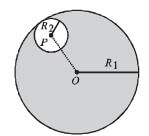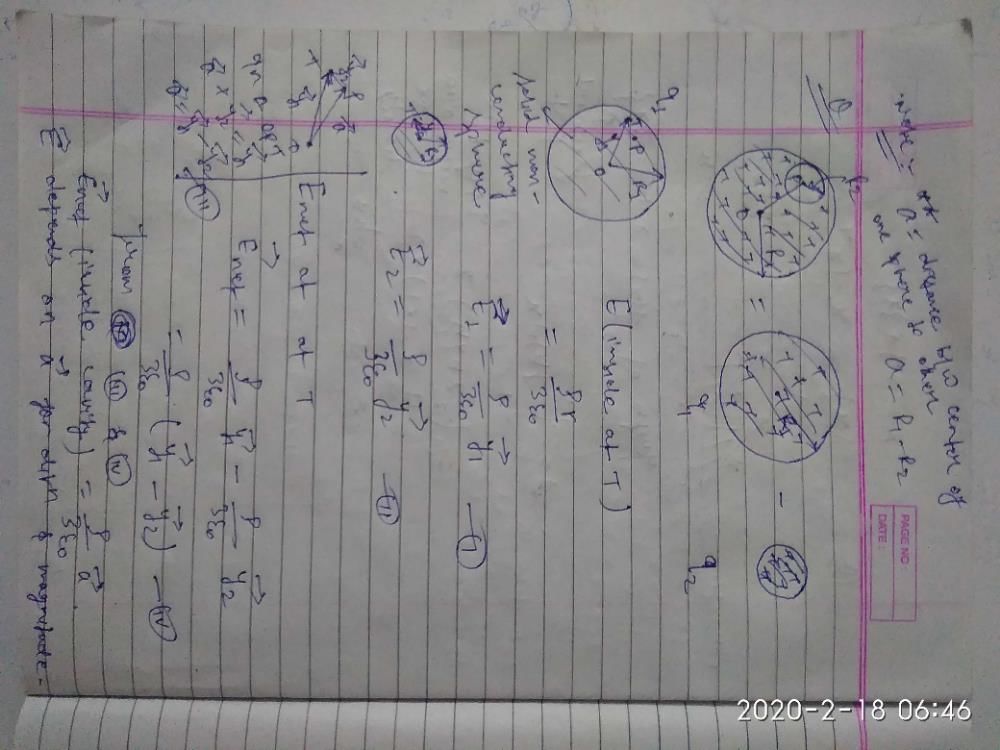JEE Exam > JEE Questions > Consider a uniform spherical charge distribut...
Start Learning for Free
Consider a uniform spherical charge distribution of radius R1 centred at the origin O. In this distribution, a spherical cavity of radius R2, centred at P with distance OP = a = R1 – R2 (see figure) is made. If the electric field inside the cavity at position  then the correct statement(s) is (are)
then the correct statement(s) is (are)
 then the correct statement(s) is (are)
then the correct statement(s) is (are)
- a)
 uniform, its magnitude is independent of R2 but its direction depends
uniform, its magnitude is independent of R2 but its direction depends 
- b)
 is uniform, its magnitude depends on R2 and its direction depends
is uniform, its magnitude depends on R2 and its direction depends 
- c)
 uniform, its magnitude is independent of a but its direction depends on
uniform, its magnitude is independent of a but its direction depends on 
- d)
 uniform and both its magnitude and direction depend on
uniform and both its magnitude and direction depend on 
Correct answer is option 'D'. Can you explain this answer?
| FREE This question is part of | Download PDF Attempt this Test |
Most Upvoted Answer
Consider a uniform spherical charge distribution of radius R1 centred ...

Free Test
| FREE | Start Free Test |
Community Answer
Consider a uniform spherical charge distribution of radius R1 centred ...
Assume the cavity to contain similar charge distribution of positive and negative charge as the rest of sphere.
Electric field at M due to uniformly distributed charge of the whole sphere of radius R1
Electric field at M due to uniformly distributed charge of the whole sphere of radius R1

Electric field at M due the negative charge distribution in the cavity


∴ The total electric field at M is


(d) is the correct option
Attention JEE Students!
To make sure you are not studying endlessly, EduRev has designed JEE study material, with Structured Courses, Videos, & Test Series. Plus get personalized analysis, doubt solving and improvement plans to achieve a great score in JEE.

|
Explore Courses for JEE exam
|

|
Similar JEE Doubts
Consider a uniform spherical charge distribution of radius R1 centred at the origin O. In this distribution, a spherical cavity of radius R2, centred at P with distance OP = a = R1 – R2 (see figure) is made. If the electric field inside the cavity at position then the correct statement(s) is (are)a)uniform, its magnitude is independent of R2 but its direction depends b)is uniform, its magnitude depends on R2 and its direction depends c)uniform, its magnitude is independent of a but its direction depends ond)uniform and both its magnitude and direction depend onCorrect answer is option 'D'. Can you explain this answer?
Question Description
Consider a uniform spherical charge distribution of radius R1 centred at the origin O. In this distribution, a spherical cavity of radius R2, centred at P with distance OP = a = R1 – R2 (see figure) is made. If the electric field inside the cavity at position then the correct statement(s) is (are)a)uniform, its magnitude is independent of R2 but its direction depends b)is uniform, its magnitude depends on R2 and its direction depends c)uniform, its magnitude is independent of a but its direction depends ond)uniform and both its magnitude and direction depend onCorrect answer is option 'D'. Can you explain this answer? for JEE 2024 is part of JEE preparation. The Question and answers have been prepared according to the JEE exam syllabus. Information about Consider a uniform spherical charge distribution of radius R1 centred at the origin O. In this distribution, a spherical cavity of radius R2, centred at P with distance OP = a = R1 – R2 (see figure) is made. If the electric field inside the cavity at position then the correct statement(s) is (are)a)uniform, its magnitude is independent of R2 but its direction depends b)is uniform, its magnitude depends on R2 and its direction depends c)uniform, its magnitude is independent of a but its direction depends ond)uniform and both its magnitude and direction depend onCorrect answer is option 'D'. Can you explain this answer? covers all topics & solutions for JEE 2024 Exam. Find important definitions, questions, meanings, examples, exercises and tests below for Consider a uniform spherical charge distribution of radius R1 centred at the origin O. In this distribution, a spherical cavity of radius R2, centred at P with distance OP = a = R1 – R2 (see figure) is made. If the electric field inside the cavity at position then the correct statement(s) is (are)a)uniform, its magnitude is independent of R2 but its direction depends b)is uniform, its magnitude depends on R2 and its direction depends c)uniform, its magnitude is independent of a but its direction depends ond)uniform and both its magnitude and direction depend onCorrect answer is option 'D'. Can you explain this answer?.
Consider a uniform spherical charge distribution of radius R1 centred at the origin O. In this distribution, a spherical cavity of radius R2, centred at P with distance OP = a = R1 – R2 (see figure) is made. If the electric field inside the cavity at position then the correct statement(s) is (are)a)uniform, its magnitude is independent of R2 but its direction depends b)is uniform, its magnitude depends on R2 and its direction depends c)uniform, its magnitude is independent of a but its direction depends ond)uniform and both its magnitude and direction depend onCorrect answer is option 'D'. Can you explain this answer? for JEE 2024 is part of JEE preparation. The Question and answers have been prepared according to the JEE exam syllabus. Information about Consider a uniform spherical charge distribution of radius R1 centred at the origin O. In this distribution, a spherical cavity of radius R2, centred at P with distance OP = a = R1 – R2 (see figure) is made. If the electric field inside the cavity at position then the correct statement(s) is (are)a)uniform, its magnitude is independent of R2 but its direction depends b)is uniform, its magnitude depends on R2 and its direction depends c)uniform, its magnitude is independent of a but its direction depends ond)uniform and both its magnitude and direction depend onCorrect answer is option 'D'. Can you explain this answer? covers all topics & solutions for JEE 2024 Exam. Find important definitions, questions, meanings, examples, exercises and tests below for Consider a uniform spherical charge distribution of radius R1 centred at the origin O. In this distribution, a spherical cavity of radius R2, centred at P with distance OP = a = R1 – R2 (see figure) is made. If the electric field inside the cavity at position then the correct statement(s) is (are)a)uniform, its magnitude is independent of R2 but its direction depends b)is uniform, its magnitude depends on R2 and its direction depends c)uniform, its magnitude is independent of a but its direction depends ond)uniform and both its magnitude and direction depend onCorrect answer is option 'D'. Can you explain this answer?.
Solutions for Consider a uniform spherical charge distribution of radius R1 centred at the origin O. In this distribution, a spherical cavity of radius R2, centred at P with distance OP = a = R1 – R2 (see figure) is made. If the electric field inside the cavity at position then the correct statement(s) is (are)a)uniform, its magnitude is independent of R2 but its direction depends b)is uniform, its magnitude depends on R2 and its direction depends c)uniform, its magnitude is independent of a but its direction depends ond)uniform and both its magnitude and direction depend onCorrect answer is option 'D'. Can you explain this answer? in English & in Hindi are available as part of our courses for JEE.
Download more important topics, notes, lectures and mock test series for JEE Exam by signing up for free.
Here you can find the meaning of Consider a uniform spherical charge distribution of radius R1 centred at the origin O. In this distribution, a spherical cavity of radius R2, centred at P with distance OP = a = R1 – R2 (see figure) is made. If the electric field inside the cavity at position then the correct statement(s) is (are)a)uniform, its magnitude is independent of R2 but its direction depends b)is uniform, its magnitude depends on R2 and its direction depends c)uniform, its magnitude is independent of a but its direction depends ond)uniform and both its magnitude and direction depend onCorrect answer is option 'D'. Can you explain this answer? defined & explained in the simplest way possible. Besides giving the explanation of
Consider a uniform spherical charge distribution of radius R1 centred at the origin O. In this distribution, a spherical cavity of radius R2, centred at P with distance OP = a = R1 – R2 (see figure) is made. If the electric field inside the cavity at position then the correct statement(s) is (are)a)uniform, its magnitude is independent of R2 but its direction depends b)is uniform, its magnitude depends on R2 and its direction depends c)uniform, its magnitude is independent of a but its direction depends ond)uniform and both its magnitude and direction depend onCorrect answer is option 'D'. Can you explain this answer?, a detailed solution for Consider a uniform spherical charge distribution of radius R1 centred at the origin O. In this distribution, a spherical cavity of radius R2, centred at P with distance OP = a = R1 – R2 (see figure) is made. If the electric field inside the cavity at position then the correct statement(s) is (are)a)uniform, its magnitude is independent of R2 but its direction depends b)is uniform, its magnitude depends on R2 and its direction depends c)uniform, its magnitude is independent of a but its direction depends ond)uniform and both its magnitude and direction depend onCorrect answer is option 'D'. Can you explain this answer? has been provided alongside types of Consider a uniform spherical charge distribution of radius R1 centred at the origin O. In this distribution, a spherical cavity of radius R2, centred at P with distance OP = a = R1 – R2 (see figure) is made. If the electric field inside the cavity at position then the correct statement(s) is (are)a)uniform, its magnitude is independent of R2 but its direction depends b)is uniform, its magnitude depends on R2 and its direction depends c)uniform, its magnitude is independent of a but its direction depends ond)uniform and both its magnitude and direction depend onCorrect answer is option 'D'. Can you explain this answer? theory, EduRev gives you an
ample number of questions to practice Consider a uniform spherical charge distribution of radius R1 centred at the origin O. In this distribution, a spherical cavity of radius R2, centred at P with distance OP = a = R1 – R2 (see figure) is made. If the electric field inside the cavity at position then the correct statement(s) is (are)a)uniform, its magnitude is independent of R2 but its direction depends b)is uniform, its magnitude depends on R2 and its direction depends c)uniform, its magnitude is independent of a but its direction depends ond)uniform and both its magnitude and direction depend onCorrect answer is option 'D'. Can you explain this answer? tests, examples and also practice JEE tests.

|
Explore Courses for JEE exam
|

|
Suggested Free Tests
Signup for Free!
Signup to see your scores go up within 7 days! Learn & Practice with 1000+ FREE Notes, Videos & Tests.



















